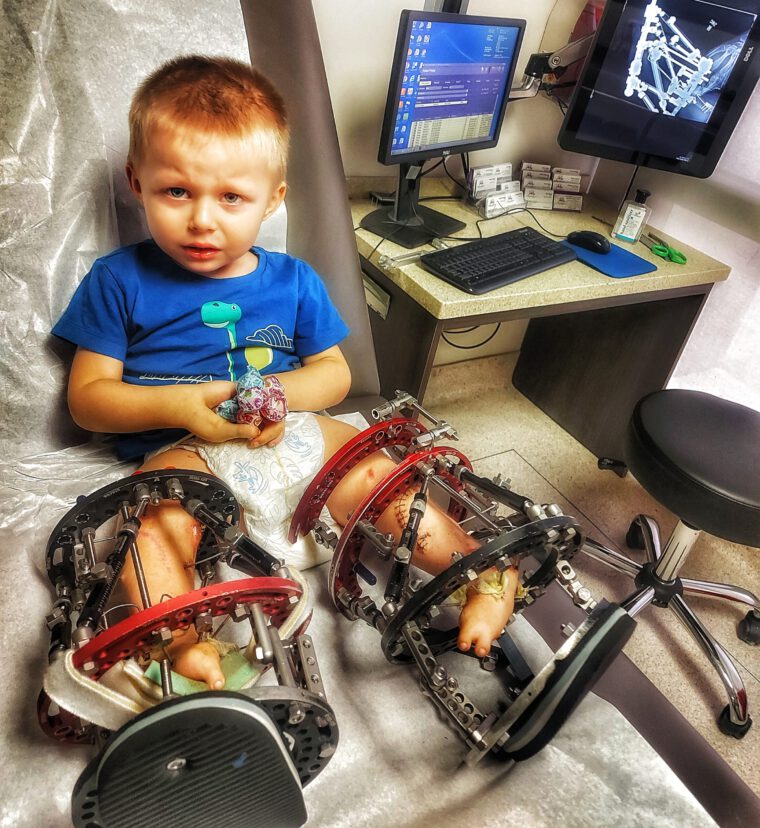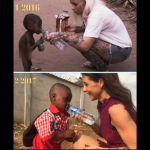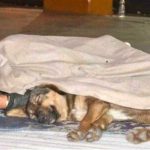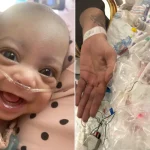Bruno Waszczuk: A Remarkable Journey Through Congenital Limb Deficiencies, Complex Surgeries, and Lifelong Rehabilitation

Bruno Waszczuk was born in Szczecin, Poland, with severe congenital limb deficiencies that initially seemed insurmountable. From birth, Bruno lacked tibial bones in both legs, had no knees, and was missing multiple fingers and toes. These rare malformations made standard treatment options in Poland nearly impossible. In many similar cases, children were advised to undergo amputation and rely on prosthetic limbs for life. However, Bruno’s parents, Nicola and Oskar, were determined to explore every avenue to give their son the chance to walk with his natural legs.
Early Stage: Diagnosis and the Family’s Determination
From the very beginning, Bruno’s condition was extremely complex. Without tibial bones, his legs could not bear weight, and the absence of knees made normal walking nearly impossible. Missing fingers and toes further limited his mobility and dexterity. Each step carried a risk of injury or deformity. Doctors explained frankly that without advanced surgical intervention, Bruno would spend his life in a wheelchair or rely on limited prosthetics.
Recognizing the severity of his condition, Bruno’s parents began searching internationally and connected with Dr. Paley in the United States, a specialist experienced in advanced limb reconstruction for children with congenital tibial deficiencies. This connection marked a turning point, opening the path for a long-term treatment plan involving multiple surgeries, extensive rehabilitation, and continuous care. The family understood that the process would be physically painful, mentally demanding, and financially challenging.

The Surgical Journey: Pain, Perseverance, and Hope
In October 2020, Bruno traveled to the U.S. with his parents to begin the first series of surgeries. The initial procedures involved placing external fixation devices on his legs. These frames facilitated gradual bone lengthening through distraction osteogenesis, with each millimeter carefully adjusted daily. Though highly effective, the process was extremely painful and required Bruno’s patience and cooperation over extended periods.
Over the next six months, Bruno underwent multiple procedures, including the insertion of pins and rods into his leg bones and adjustments of the external frames. Doctors monitored growth carefully to ensure proper alignment and maintain joint flexibility. Despite the discomfort, Bruno showed remarkable resilience and followed daily physiotherapy exercises faithfully.
Complications were inevitable. Infections around surgical sites required antibiotics, and some rods became displaced, necessitating urgent corrective surgery. Pain management was a critical aspect of care, balancing relief with the need for mobility and alertness.
Emotional and Physical Support
Bruno’s cooperation was sometimes challenged due to the prolonged, painful, and repetitive nature of treatment. His parents worked closely with physical therapists and child psychologists to provide emotional support, maintain motivation, and encourage participation in daily exercises. Guided play, structured movement, and positive reinforcement became essential elements of his rehabilitation program.
Subsequent Phases: Continued Surgery and Rehabilitation
By mid-2021, Bruno had completed the initial surgeries and returned to Poland. Bone lengthening procedures needed to be repeated in subsequent surgeries to achieve optimal leg length and mobility. Each operation carried the risk of infection, delayed healing, or additional intervention if bone alignment deviated.
Throughout 2021–2022, Bruno underwent follow-up surgeries, including rod removal, frame adjustments, and alignment refinements. These intricate procedures ensured proper bone growth and functional leg performance. Physical therapy remained crucial, focusing on strengthening the quadriceps, hamstrings, and calves, as well as balance training, stretching, and maintaining joint range of motion. His parents maintained daily therapy routines, encouraging him to persevere through pain and fatigue.
Milestones and Achievements
In November 2022, Bruno underwent his seventh major surgery, simultaneously addressing both legs, with Dr. Paley traveling to Poland for the procedure. This surgery removed remaining bone obstructions and adjusted lengthening devices to continue bone growth. Postoperative care involved close monitoring, pain management, infection prevention, and intensive physiotherapy.
Bruno’s progress was remarkable. The external devices successfully increased leg length, improved alignment, and gradually enhanced weight-bearing capacity. Key milestones included standing with support, taking partial steps during therapy, and building endurance. Each small achievement marked a significant step in functional improvement.

Transition to Home-Based Rehabilitation
By 2023, Bruno transitioned from hospital care to intensive home rehabilitation. His parents continued assisted walking, balance exercises, and range-of-motion activities. Regular orthopedic follow-ups ensured proper growth plate development and stability of previous interventions. Adaptive equipment and braces supported safe mobility.
In addition to physical challenges, Bruno faced emotional and psychological adjustments. Repeated hospitalizations and prolonged treatment placed stress on the family. Pediatric psychologists helped him manage anxiety, frustration, and build resilience. Play therapy, social engagement, and positive reinforcement were integrated into his daily routine to maintain motivation.
Looking Ahead
As of 2025, Bruno continues complex rehabilitation. His legs have undergone multiple lengthening procedures, device adjustments, and corrective interventions. The long-term goal is independent walking, participation in daily activities, and a quality of life comparable to peers without congenital limb deficiencies.
Bruno’s journey highlights the critical role of international collaboration in pediatric orthopedic care. Access to specialized surgeons, advanced surgical techniques, and comprehensive rehabilitation programs can dramatically improve outcomes for children with severe congenital limb deficiencies. His story demonstrates the potential to restore function, preserve natural limbs, and enhance quality of life.
Extraordinary Determination and Resilience
Bruno has shown exceptional courage and determination. Despite repeated surgeries, painful adjustments, and rigorous rehabilitation, he continues to engage in therapy, communicate his needs, and maintain a positive attitude. His perseverance exemplifies the remarkable strength of the human spirit.
Conclusion
Bruno’s journey remains challenging, with future surgeries, ongoing physiotherapy, and careful monitoring of bone growth and alignment. Each milestone represents progress toward independent mobility. His story serves as a powerful example of resilience, dedication, and the collaboration between family and medical teams to provide children with rare congenital disorders a chance at a normal, active life.











